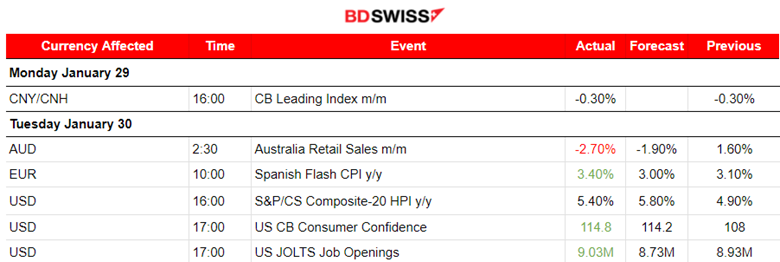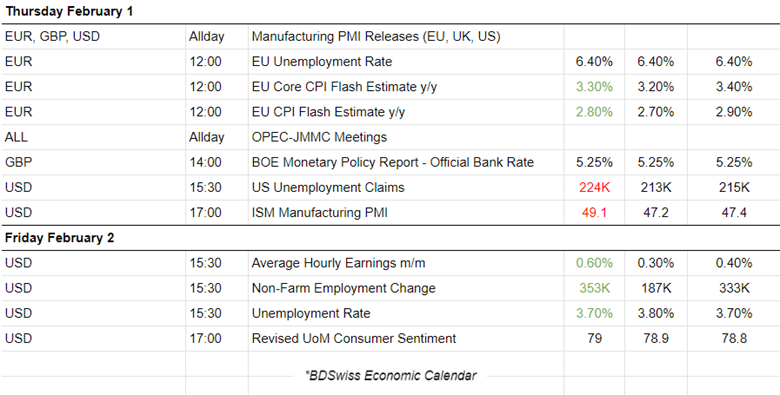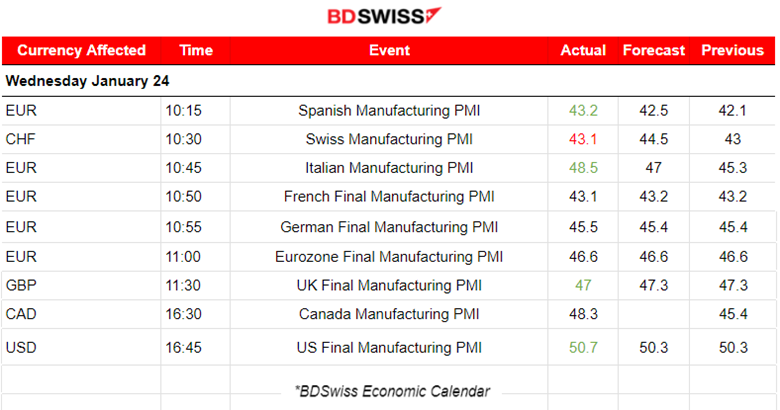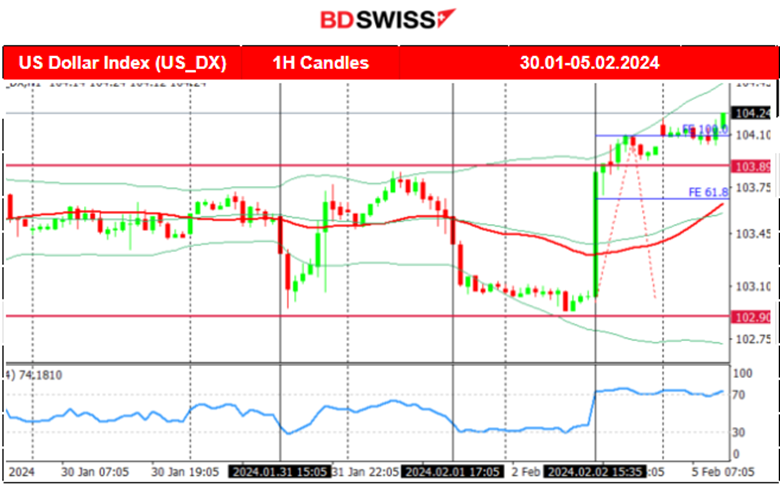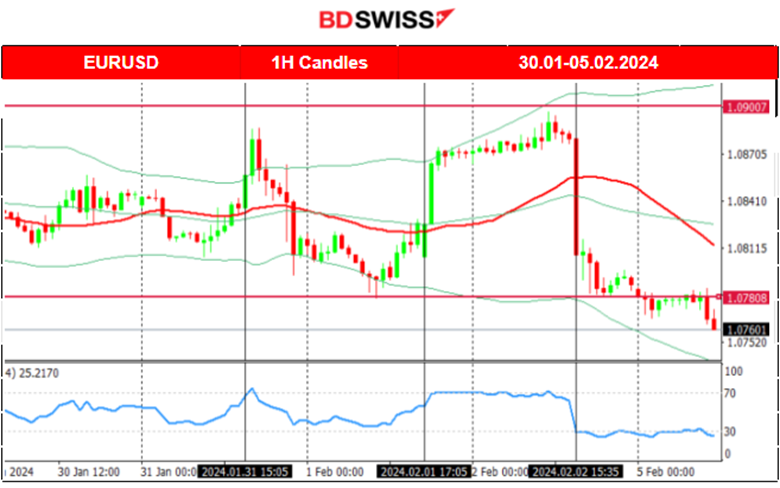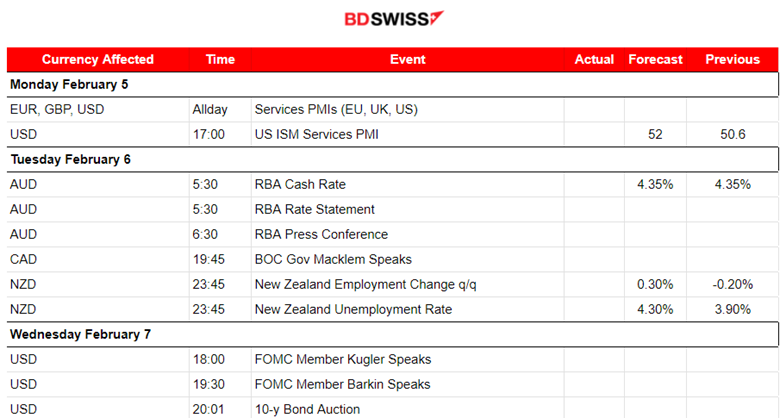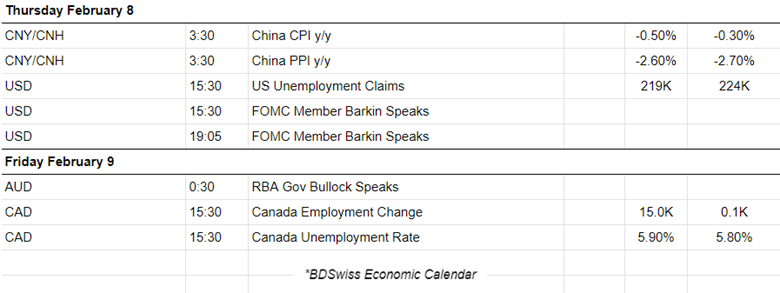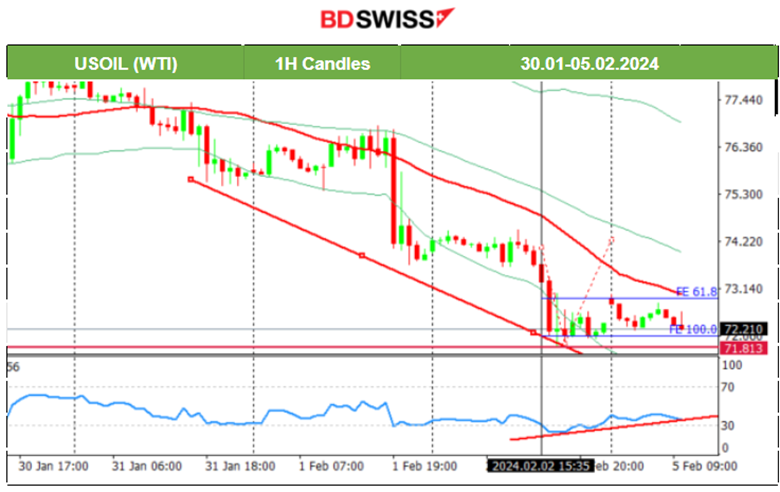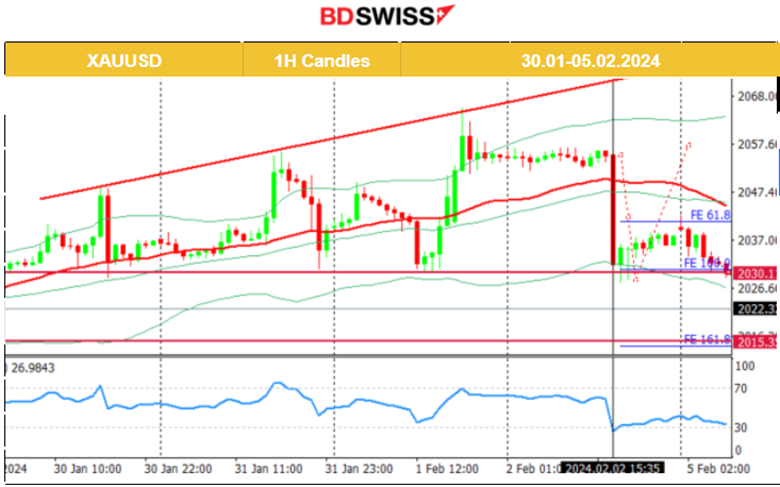Previous week’s events (week 29.01 - 02.02.2024)
Announcements
US economy
U.S. Consumer confidence rose in January, as recent reports suggested. It increased to a two-year high in January amid slowing inflation and expectations that the Federal Reserve would start cutting interest rates soon.
The consumer confidence index rose to 114.8, the highest reading since December 2021, from a downwardly revised 108.0 in December. The anticipation of lower interest rates ahead and indications of higher jobless claims played their part in this, during that period in forming such expectations.
The JOLTS U.S. job openings report showed that the figure increased in December, more than expected, and data for the prior month was revised higher, suggesting that the labour market likely remains stronger than expected.
The U.S. ADP report showed that the private payrolls rose far less than expected in January showing signs that the labour market is cooling after December’s hot data. These latest labour market data reports indicated cooling which in turn caused market expectations to be formed in such a way that Non-Farm payrolls would actually be reported lower for January.
According to the U.S. labour data on Friday last week, including NFP, job growth accelerated in January and wages increased by the most in nearly two years, against expectations, causing a shock in the market and boosting the USD.
The Non-Farm Employment change was reported surprisingly at 353K, higher than the previous 333K for December, while the market was actually expecting lower figures. The unemployment rate was reported steady at 3.7% last month, remaining below 4% for two consecutive years.
Average hourly earnings increased 0.6% in January, the biggest gain since March 2022, after rising 0.4% in December, supporting views that the Fed will not move quickly to lower borrowing costs.
This confirms that the labour market conditions are actually pretty strong, thus making it difficult for the Federal Reserve to start cutting interest rates soon. According to the Federal Reserve statements, March is out of the table for interest rate cuts, moving the expected start date/month to May.
Australia economy
December’s report yesterday for Australia’s retail sales showed a huge decline surprising the market while annual growth in spending slowed to lows last seen during the COVID-19 pandemic lockdowns.
Retail sales decline was reported at 2.7% on a seasonally adjusted basis, after rising 1.6% in November.
FOMC - Fed fund rate
FOMC: Policymakers announced last week, on the 31st Jan, an unchanged interest rate policy keeping the Fed Funds Rate steady, high at 5.5%, until more data support that inflation will indeed retreat as expected lower reaching the desired target, speculating that it will cut rates significantly later this year. Fed’s Powell mentioned that it’s unlikely to act as quickly as March for a policy change.
The current economic situation in the U.S. is favourable, considering the high borrowing costs in place. Both sectors of the economy show expansion and surprisingly, a strong NFP report was reported on Friday. Inflation, however, despite the fact that it has eased over the past year, remains elevated. Key statement:
“The Committee does not expect it will be appropriate” to cut “until it has gained greater confidence that inflation is moving sustainably” to 2%.
The above signals a delay in interest rate cuts that boosts the dollar in the short term.
BoE interest rates
The Bank of England (BOE) kept the Bank rate steady but announced that borrowing costs would be kept “under review.” The central bank Governor Andrew Bailey said inflation was “moving in the right direction”. Bailey further said the central bank was still cautious and inflation falling to its 2% target would not be “job done.”
Currency markets impact – Past releases (week 29.01-02.02.2024)
Server Time / Timezone EEST (UTC+02:00).
Australia’s Retail Sales figure was reported negative for December 2023, the seasonally adjusted estimate fell 2.7% month-on-month. That was more negative than the forecast but the market was not affected greatly at the time of the release. No major impact on the AUD pairs.
According to the Spanish Flash annual CPI figure reported on the 30th Jan, the estimated annual inflation in January 2024 is 3.4%, higher than the expected figure. No major impact on EUR pairs was recorded.
The CB Consumer Confidence figure was released higher, 114.8 versus 108. This shows how more optimistic are the U.S. consumers about the state of the economy than they’ve been in more than two years. Future positive expectations are reflecting slower inflation, anticipation of lower interest rates and improvement in labour market conditions. The JOLTS report, released at the same time, eventually confirmed that in December the labour market conditions indeed were hotter than anticipated. The figure shows that U.S. job openings unexpectedly rose to the highest level in three months. At the time of these report releases, the U.S. dollar appreciated moderately against other currencies. The EURUSD dropped 20 pips at that time but the effect faded soon.
On the 31st Jan, the inflation-related data for Australia were released at 2:30. The annual CPI figure was reported lower, 3.4%, surprising even the Bank of Australia’s economists on how inflation moves significantly in the desired direction. The market responded with an intraday shock and AUD depreciation. AUDUSD dropped near 30 pips until finding support and significant retracement.
The U.S. ADP Non-Farm Employment change figure showed that private sector employment increased only by 107K jobs in January, lower than the expected 148K and confirming that the labour market is slowing this year. At the time of the release, the USD suffered depreciation at that time against the other currencies. The effect soon reversed though as the FOMC news was approaching.
The Fed, on the 31st Jan, announced that it had decided to keep the Fed Fund Rate steady and elevated at 5.5%. At the time of the release, the market experienced a shock but it was rather moderate. The dollar index had not settled into one direction remaining close to the 30-period MA. During the press conference however that started at 21:30, the USD appreciated against other currencies significantly, reversing from the downside.
Manufacturing PMI releases
Eurozone PMIs
In Spain, the manufacturing sector continues to contract despite an improved figure. It is still significantly lower than 50, at 43.2 points in contraction territory during January with falls in output, new orders, employment, and stocks.
Italian business conditions deteriorated at a softer rate in January as the figure suggests, which is reported higher than expected, at 48.5 versus 47 points. Declines in production and factory orders slowed favourably. Firms continued to reduce input buying levels and deplete stocks in January.
France’s manufacturing sector is showing that it remains under a lot of pressure as incoming data for January suggest. The PMI figure is reported to be 43.1 points reflecting strong contraction in output, new orders and employment.
Germany also faces a downturn in the manufacturing sector and the PMI is not improving, however, the sector showed further signs of easing in January, with output, new orders and purchasing activity all falling at the slowest rates.
In the Eurozone the PMI is still reported in contraction, 46.6 points, however, reports show that the slump in the Eurozone’s manufacturing sector eased in January. Factory output and new orders continued to decline, however at the softest rates. Cutbacks to purchasing activity, stocks of inputs and employment cooled. Business confidence rose to a nine-month high. Decreases in both input costs and output prices gathered momentum.
United Kingdom PMIs
U.K. manufacturing sector contracts as January saw output and new orders decline further, leading to additional job losses and cutbacks in purchasing and stock holdings. Furthermore, the Red Sea crisis hits supply chains and contributes to rising costs. The Red Sea has experienced a surge in regional tensions recently, leading to attacks on commercial vessels, and causing significant rerouting of maritime traffic. The PMI was reported at 47 points, confirming that there is no improvement in the sector at all.
United States PMI
The U.S. continues to lead with the best conditions in the manufacturing business. It has faced the strongest improvement in manufacturing performance since September 2022. The PMI figure was reported in the expansion area which is above 50, at 50.7 points and more than the expected 50.3 figure.
On the 1st Feb, the Eurozone’s CPI flash estimates showed more than expected figures. No major shock was recorded, however, the EUR faced a positive impact and the EURUSD continued steadily upwards after the release. Overall it seems that the Euro-area inflation slowed down in January, less than expected, however towards the target.
The Bank of England (BoE) announced the decision to keep the Bank rate at 5.25%. The market responded with GBP appreciation at the time of the release and a jump was recorded for GBPUSD near 60 pips before a retracement took place.
The U.S. Unemployment Claims report showed that in the week ending January 27, the advance figure for seasonally adjusted initial claims was 224K, more than the expected figure, showing an increase of 9K from the previous week’s revised level indicating labour market cooling. The ISM Manufacturing PMI report, however, showed a different picture. This measure of U.S. factory activity climbed to a 15-month high at the start of the year, suggesting manufacturing is starting to stabilise. The market responded with steady and long USD depreciation, with USD pairs moving rapidly in one direction and not experiencing significant retracement during the trading day.
The figures on Friday, 2nd Feb, took everyone by surprise and caused an intraday shock with a huge impact on the USD and related assets, extending to the stock market and more. The monthly Average Hourly Earnings change was reported higher than expected at 0.6% versus the 0.3% expected figure, the NF Employment change was reported amazingly at 353K versus the expected change at 187K, while the unemployment rate was reported stable at 3.70%.
The market reacted with great USD appreciation against other currencies, clearly seen in the dollar index. USD pairs (USD as Quote) dropped heavily at the time of the figure releases. EURUSD dropped around 100 pips. Gold dropped near 28 USD/oz. The U.S. Indices dropped at the time of the releases but reversed soon after the exchange opening, continuing to the upside and closing higher overall. No significant retracement took place on the same day for FX pairs even when support/resistance was reached. This reaction signals that the market expects the Fed to keep interest rates high for longer and increases uncertainty about how much longer the economy is going to face high borrowing costs.
Chair Jerome Powell said in an interview broadcast Sunday night that the Federal Reserve remains on track to cut interest rates three times this year, a move that’s expected to begin as early as May.
Forex markets monitor
Dollar Index (US_DX)
Quite obvious that after some period of experiencing sideways movement with low volatility, the dollar index on the 31st Jan dropped heavily during the ADP private employment change news reaching the support near 103 points. It reversed soon after and back to the 30-period MA moving with high volatility. The FOMC news at 21:00 caused a shock in the market, however after the index deviated from MA it returned quickly to the mean and settled very close to it. Later, on the 1st Feb, it experienced another drop during the higher-than-expected unemployment claims figure release. Without retracement taking place, the index remained low and tested again the 103 points support on the 2nd Feb, unsuccessfully. On the same day, during the NFP news the USD strengthened heavily, the dollar index jumped breaking the resistance at near 103.8, moving higher. Currently, the dollar index is experiencing strong momentum to the upside.
EUR/USD
The pair experienced the opposite path in every case since the USD is driving the market. On the 31st Jan, the pair moved upwards as the USD depreciated from the U.S. ADP report. Reversal followed. On the 1st of Feb, higher Jobless claims caused another depreciation of the USD causing the pair to move to the upside as expectations formed regarding less employment change reported next. However, on the 2nd Feb, the NFP, Wage and Jobless rate data surprised the market with figures against the expectations, causing the USD to appreciate heavily and the EURUSD to drop. The USD currently is gaining more strength and thus more ground against the EUR, causing the pair to fall further. It might be the case that it reaches the next support at near 1.07200.
Crypto markets monitor
BTC/USD
Bitcoin faced a shock during the NFP report release on Friday but closed near flat for the trading day. Volatility levels lowered after that event and a triangle was formed during the weekend. On Sunday, 4th Feb, the price broke the triangle to the downside reaching the support at 42200 USD. It soon reversed after that crossing the 30-period MA on its way to the upside and remains currently settled near 43000 USD.
Next week’s events (05 - 09.02.2024)
Coming up
Services PMI figures for January, giving important information about the sector and helping in providing the whole picture in regards to business conditions in the mentioned regions.
The Reserve Bank of Australia (RBA) decides on interest rates and is expected to keep a steady policy.
New Zealand and Canada labour market data are to be reported shaking the markets a bit and providing the necessary data to the central banks in order to speculate when rate cut talks could take place.
Currency markets impact
Today, 5th Feb, Services PMI figures could shake the markets a bit, USD is obviously affected by the forming expectations regarding interest rate cuts. At 17:00, USD pairs might see more volatility due to the ISM PMI figure release.
On the 6th of February, during the Asian session, the RBA will announce its decision on interest rates. Another unchanged rate view is in place. As usual, no surprises will probably not cause high volatility but later during the press conference at 6:30, the market could see more volatility for the AUD pairs or even an intraday shock.
Employment data for New Zealand will be released at 23:45 and are expected to increase volatility. The market expects that employment change or the last quarter is to be released higher, however, the same expectation applies to the unemployment rate. An intraday shock is possible, affecting the NZD pairs highly during that time. Usually, retracements are difficult to complete during that time due to low activity after the news.
China’s inflation data are to be released at 3:30, 8th Feb, probably causing higher volatility levels than normal. Deflation is expected to continue. AUD pairs could be affected greatly during the Asian session considering that there are strong surprises with the release of the actual figures.
Unemployment claims are expected to be reported lower, coinciding with the recent NFP data showing strength for the U.S. labour market. Staying close to the 200K level is something normal to expect after these recent developments and new data are revealed.
Canada’s labour data is going to be reported on the 9th Feb. An improvement in employment change is expected while the unemployment rate is expected to be reported higher. The market could see CAD intraday shock during that time when activity is high. The Bank of Canada kept the policy range unchanged and awaits to see cooling. It might be the case where the market will be faced with lower-than-expected employment growth.
Commodities markets monitor
US Crude Oil
Crude’s price signalled a downward movement and on the 31st it dropped to the support of 75.5 USD/b, before retracing back to the mean. On the 1st of February it tested that support and successfully broke it, coming down to near 73.6 USD/b before retracing. On the 2nd Feb the price was stable until the NFP news was released. Then the price saw a rapid drop breaking the support at 73.6 USD/b moving towards the next at near 71.8 USD/b before retracing to the 61.8 Fibo level. A clear downtrend as it seems for now. However, that might end soon while crude shows resilience to fall further and the RSI signals bullish divergence (higher lows).
Gold (XAU/USD)
Gold, on the 31st Jan, broke the resistance, reaching 2055 USD/oz prior to the FOMC news. The heavy reversal followed and increased volatility after the USD was affected positively by the Fed’s statements. On the 1st of February Gold tested the support near 2031 USD/oz unsuccessfully and reversed with a jump upwards reaching the resistance near 2065 USD/oz before retracing. The market shook on the 2nd Feb, at the release of the NFP news. Gold dropped heavily to around 28 USD, found support and soon after it retraced to the 61.8 Fibo level. Obviously, the drop was attributed to USD strengthening and the effect could possibly continue for longer. Currently Gold broke the 2030 USD/oz support moving lower, possibly towards the next support at near 2015 USD/oz.
Equity markets monitor
NAS100 (NDX)
Price movement
NAS100 reversed on the 1st Feb, moving to the upside crossing the 30-period MA and reaching the resistance at 17,550 USD. After some sideways movement with low volatility early on the 2nd Feb, the NFP news at 15:30 caused an intraday shock that brought the U.S. indices down to lower levels for some time. NAS100 reached the support near 17,400 USD before a huge reversal took place. The index reversed, crossing the 30-period MA on the way up and reaching the resistance higher at near 17,700 USD before retracing. The RSI is currently signalling a bearish divergence, however the market is about to test that intraday resistance for now.
Risk Warning: CFDs are complex instruments and come with a high risk of losing your invested capital due to leverage. You should consider whether you understand how CFDs work and whether you can afford to take the high risk of losing your money.
The content of this material and/or any information provided by BDSwiss Group should not be in any way construed, either explicitly or implicitly, directly or indirectly, as investment advice, recommendation or suggestion of an investment strategy with respect to a financial instrument and it is not intended to provide a sufficient basis on which to make investment decisions, in any manner whatsoever. Any information, views or opinions presented in this material have been obtained or derived from sources believed by the BDSwiss Research Department to be reliable, but BDSwiss makes no representation as to their accuracy or completeness. BDSwiss Group accepts no liability for losses arising from the use of this data and information. The data and information contained herein are for background purposes only and do not purport to be full or complete.
Recommended Content
Editors’ Picks
USD/JPY briefly recaptures 160.00, then pulls back sharply

Having briefly recaptured 160.00, USD/JPY pulls back sharply toward 159.00 on potential Japanese FX intervention risks. The Yen tumbles amid news that Japan's PM lost 3 key seats in the by-election. Holiday-thinned trading exaggerates the USD/JPY price action.
AUD/USD extends gains above 0.6550 on risk flows, hawkish RBA expectations

AUD/USD extends gains above 0.6550 in the Asian session on Monday. The Aussie pair is underpinned by increased bets of an RBA rate hike at its May policy meeting after the previous week's hot Australian CPI data. Risk flows also power the pair's upside.
Gold stays weak below $2,350 amid risk-on mood, firmer USD

Gold price trades on a softer note below $2,350 early Monday. The recent US economic data showed that US inflationary pressures stayed firm, supporting the US Dollar at the expense of Gold price. The upbeat mood also adds to the weight on the bright metal.
Ethereum fees drops to lowest level since October, ETH sustains above $3,200

Ethereum’s high transaction fees has been a sticky issue for the blockchain in the past. This led to Layer 2 chains and scaling solutions developing alternatives for users looking to transact at a lower cost.
Week ahead: Hawkish risk as Fed and NFP on tap, Eurozone data eyed too

Fed meets on Wednesday as US inflation stays elevated. Will Friday’s jobs report bring relief or more angst for the markets? Eurozone flash GDP and CPI numbers in focus for the Euro.

